No evidence GMO chestnut trees harm humans, animals or the environment, developers tell USDA
No evidence GMO chestnut trees harm humans, animals or the environment, developers tell USDA


Researchers at the State University of New York College of Environmental Science and Forestry (ESF) have developed Darling 58 American chestnut (Castanea dentata) trees with enhanced blight tolerance. This enhanced blight tolerance trait is generated by a single gene and can be passed on to subsequent generations through classical Mendelian inheritance.
The purpose of these trees is not to replace the surviving remnant American chestnut population, but to help rescue it by allowing introgression of the blight tolerance trait and to ultimately produce a viable and diverse restoration population from their offspring. Because offspring of Darling 58 trees will include both transgenic and non-transgenic individuals, the original wild-type American chestnut will be conserved far into the future.
To our knowledge this is the first petition for a bioengineered organism with the goal of ecological restoration, and represents a unique application for this technology to be potentially used for environmental and cultural benefits outside agriculture. This petition requests that the bioengineered Darling 58 event of American chestnut (and its offspring) be granted nonregulated status by APHIS [USDA’S Animal and Plant Health Inspection Service] because it does not pose a plant pest risk as compared to its isogenic controls or traditionally bred chestnuts. Therefore, it should no longer be considered a regulated article under 7 CFR Part 340.
The American chestnut was once one of the most abundant trees within its range in the eastern United States. It was a fast-growing and long-lived canopy tree that produced a consistent crop of healthful nuts, could be harvested for valuable lumber, and was considered a keystone species for wildlife. That ended when an invasive fungal pathogen, Cryphonectria parasitica, was introduced from Asia and killed over 3 billion American chestnuts throughout their natural range.
Tolerance to this exotic pathogen in Darling 58 American chestnuts was enhanced by adding a gene for an enzyme called oxalate oxidase (OxO). This enzyme has no direct fungicidal properties, but rather detoxifies oxalic acid (oxalate) produced by the fungus, preventing the acid from killing the chestnut’s tissues which can lead tolethal cankers on the tree.
…
Although it is from wheat, OxO is not related to gluten and does not match any known allergens from wheat or other sources. Independent nutrition analyses have confirmed that transgenic chestnuts are not nutritionally different than their wild-type relatives. Even with the ubiquity of OxO in the environment and agriculture, there are no reports of this enzyme being detrimental to human or animal health, having adverse effects on the environment, or being a plant pest risk.
Read the original post

 | Videos | More... |

Video: Nuclear energy will destroy us? Global warming is an existential threat? Chemicals are massacring bees? Donate to the Green Industrial Complex!
 | Bees & Pollinators | More... |

GLP podcast: Science journalism is a mess. Here’s how to fix it

Mosquito massacre: Can we safely tackle malaria with a CRISPR gene drive?

Are we facing an ‘Insect Apocalypse’ caused by ‘intensive, industrial’ farming and agricultural chemicals? The media say yes; Science says ‘no’
 | Infographics | More... |

Infographic: Global regulatory and health research agencies on whether glyphosate causes cancer
 | GMO FAQs | More... |

Why is there controversy over GMO foods but not GMO drugs?

How are GMOs labeled around the world?

How does genetic engineering differ from conventional breeding?
 | GLP Profiles | More... |

Alex Jones: Right-wing conspiracy theorist stokes fear of GMOs, pesticides to sell ‘health supplements’




 Trust issues: What happens when therapists use ChatGPT?
Trust issues: What happens when therapists use ChatGPT? California, Washington, Oregon forge immunization alliance to safeguard vaccine access against federal undermining
California, Washington, Oregon forge immunization alliance to safeguard vaccine access against federal undermining Fighting deforestation with CO2: Biotechnology breakthrough creates sustainable palm oil alternative for cosmetics
Fighting deforestation with CO2: Biotechnology breakthrough creates sustainable palm oil alternative for cosmetics Viewpoint — Fact checking MAHA mythmakers: How wellness influencers and RFK, Jr. undermine American science and health
Viewpoint — Fact checking MAHA mythmakers: How wellness influencers and RFK, Jr. undermine American science and health 30-year-old tomato line shows genetic resistance to devastating virus
30-year-old tomato line shows genetic resistance to devastating virus The free-range chicken dilemma: Better for birds, but with substantial costs
The free-range chicken dilemma: Better for birds, but with substantial costs Viewpoint: Video — Big Solar is gobbling up productive agricultural land and hurting farmers yet providing little energy or sustainabilty gains
Viewpoint: Video — Big Solar is gobbling up productive agricultural land and hurting farmers yet providing little energy or sustainabilty gains ‘You have to treat the brain first’:Rethinking chronic pain with Sanjay Gupta
‘You have to treat the brain first’:Rethinking chronic pain with Sanjay Gupta
